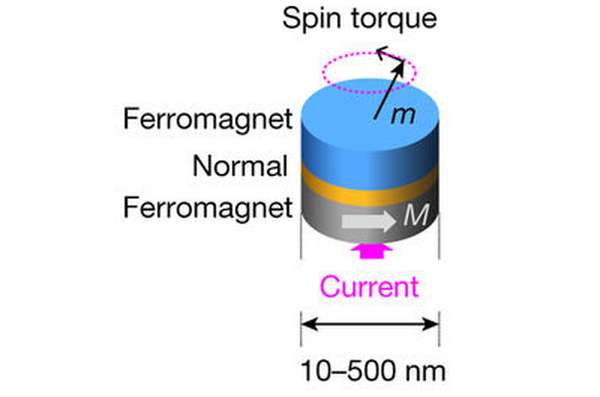July 27, 2017 report
Nanoscale magnetic device mimics behavior of neurons and can recognize human audio signals

(Phys.org)—A team of researchers with members from France, Japan and the U.S. has created a nanoscale magnetic device that mimics the behavior of neurons and can be used to recognize human audio signals. In their paper published in the journal Nature, the team describes how they built their device, how it works and how accurate they found its results. Frank Hoppensteadt with the Courant Institute of Mathematical Sciences offers a News & Views piece on the work done by the team and outlines the ideas behind neuromorphic (brain-like) computers and how some of them are being created.
As their name implies, neuromorphic computers are computing devices that work by mimicking the way the human brain works—in such systems, researchers create devices meant to mimic neurons, synapses, etc. In this new effort, the researchers built such a device and used it to recognize human audio signals. Notably, such devices are typically analog rather than digital and are expected to offer some advantages over traditional computers (reduced energy need, trainability and higher data transfer speeds) if they can be developed. In this new effort, the researchers built a nanoscale neuromorphic computer with 400 neurons arranged in an array and placed on a computer chip.
The neurons were represented by tiny three-layer pillars—a non-magnetic spacer between two ferromagnetic layers. A continuous electric current induced direct magnetization at the top of the neuron, and a secondary current caused the magnetization to oscillate in a stable way. To use the array as a computing device, the researchers spoke a single-digit number such as "one" aloud into a microphone, which fed the sound to a digital processor that converted it to an electrical signal. The electrical signal was then fed to the neuron-mimicking chip, which the researchers referred to as a reservoir. Another digital computer read the oscillations of the neurons, analyzed them, and then to translated the result to a human-recognizable form, such as displaying the word "one" on a video screen. In testing the device with multiple voices, the team found it to be 99.6 percent accurate.
The device is clearly rudimentary, and was built purely for research purposes, but it does demonstrate that neuromorphic computers are more than simple flights of fancy—they may very well augment future computers, offering new ways to process information.
More information: Jacob Torrejon et al. Neuromorphic computing with nanoscale spintronic oscillators, Nature (2017). DOI: 10.1038/nature23011
Abstract
Neurons in the brain behave as nonlinear oscillators, which develop rhythmic activity and interact to process information. Taking inspiration from this behaviour to realize high-density, low-power neuromorphic computing will require very large numbers of nanoscale nonlinear oscillators. A simple estimation indicates that to fit 108 oscillators organized in a two-dimensional array inside a chip the size of a thumb, the lateral dimension of each oscillator must be smaller than one micrometre. However, nanoscale devices tend to be noisy and to lack the stability that is required to process data in a reliable way. For this reason, despite multiple theoretical proposals and several candidates, including memristive6 and superconducting oscillators, a proof of concept of neuromorphic computing using nanoscale oscillators has yet to be demonstrated. Here we show experimentally that a nanoscale spintronic oscillator (a magnetic tunnel junction) can be used to achieve spoken-digit recognition with an accuracy similar to that of state-of-the-art neural networks. We also determine the regime of magnetization dynamics that leads to the greatest performance. These results, combined with the ability of the spintronic oscillators to interact with each other, and their long lifetime and low energy consumption, open up a path to fast, parallel, on-chip computation based on networks of oscillators.
Journal information: Nature
© 2017 Phys.org




















